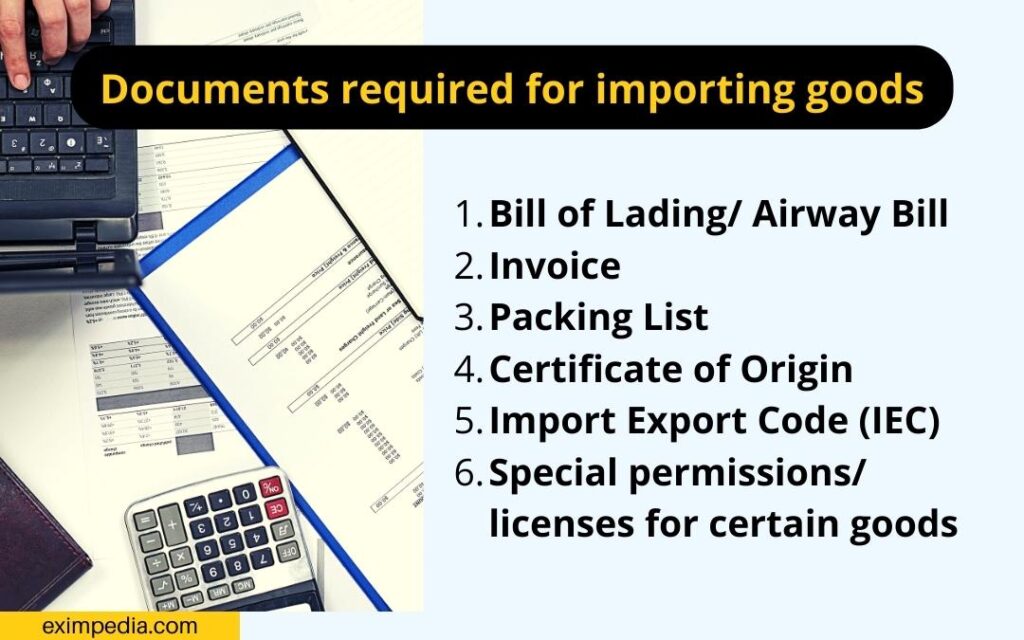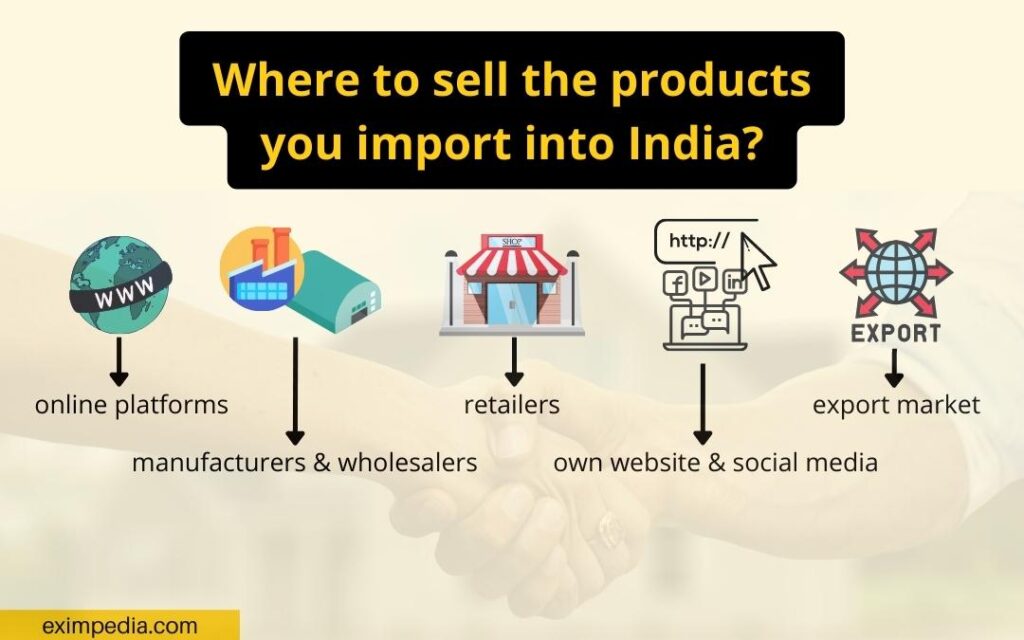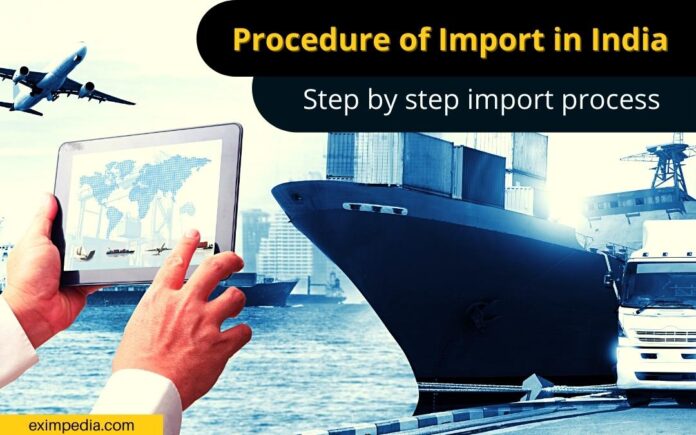This article by Eximpedia explains the entire procedure of import in India. After reading this, you will know how to import in India from any country in the world.
Table of Contents
Steps to import goods in India
If you are looking for information to import goods and products in India, then the following is the procedure to import goods in India step-by-step explained in the most simplified way.
1. Search for the products you would like to import to India.
2. Find a country where you get that product and then find the sellers in that country who sells that product.
3. Find buyers in India who will buy your product. (This depends on how you want to sell your product i.e.D2C, B2B, direct to a single buyer, etc.)
4. Contact sellers and get the quote for the product. If you accept the quote, you can first import a sample of a product to check the quality and then place bulk order later if you are satisfied.
5. Once the deal is done with the seller, find a freight forwarder and a customs house agent. The freight forwarder will help you right from picking up the shipment from the seller to bringing it to India. A Customs broker will help you in the clearance process.
6. Select a mode of transport. If sample shipment, then by air will be a better option, and if in bulk, by sea will be a better option. Deciding on the transportation chain is one of the most important steps in the procedure of import in India.
7. Ask the seller to prepare shipping documents like Invoice, Packing List, Certificate of origin, Bill of lading (if by sea), Airway bill (if by Air), and any other document needed by customs.
8. Customs clearance of your imports – Inform freight forwarder and customs broker and send them the documents for clearance. They shall send you all details required, clear your shipment out of customs, and can arrange a transporter who will transport the goods directly to your office/warehouse. So basically they will help you during the entire procedure of import and export.
9. Once you receive your shipment as ordered, the import procedure is complete.
10. Clear your pending payments and receivables.

Procedure of Import in India
The import process in India mainly works on 20 steps. You must know the transportation/ logistics chain involved in importing goods to India for that you can watch this video on Export Import Transportation Process on the Eximpedia YouTube channel.
Once you have understood the logistics chain for importing goods to India you must know the below mentioned 20 steps of importing goods in India to go ahead and actually start importing –
1. Select the product you want to import and research the product market. Select the country in which the product is available and start looking for sellers/exporters of that product in the country you have shortlisted. Then shortlist the seller/exporter from whom you want to import that product to India.
2. Negotiate with the seller/exporter and make a contract in which timelines, transportation, insurance, payment terms, etc are clearly mentioned. Read our article on Incoterms to better understand what terms are internationally accepted commercial terms in import/export.
3. Once the terms of the contract are fixed, the seller will send you a draft invoice which is called a Performa Invoice.
4. You will have to send a purchase order & export order to your seller to confirm your order for the product.
5. Once your order is confirmed, depending on your product the seller will start procuring goods or manufacturing the goods.
6. Once the goods are ready, the seller will then do the packing, stuffing of the vehicle, transportation, will do the export clearance, and get the goods ready to be sent to you as you are the importer.
7. As per the Incoterms you have decided in the contract, the goods will be loaded in the scheduled carrier i.e ship/aircraft. Your freight forwarder or the seller’s freight forwarder helps in scheduling the carrier.
8. Seller will send all the original documents such as Bill of Lading, invoice, packing list, certificate of origin, etc. by courier.
9. The carrier which is a ship/aircraft will then issue a master bill of lading to the origin agent
10. Origin agent will send the master of the bill of lading to the destination agent which is in India.
11. When the carrier is nearing India, they will then file an IGM which you can check on the customs system ICEGATE by entering the bill of lading number.
12. You will also receive a Cargo Arrival Notice (CAN) from the shipping company by mail which will help you to know that your goods carrier is arriving/arrived.
13. Your Customs House Agent (CHA/CB) will then file a Bill of entry and will receive a bill of entry number. You must also understand the import procedure and documentation from the Customs Broker.
14. You will have to pay the import duty online within one day after the bill of entry is filed or you will attract a penalty which is between 5% to 30%. Knowing when to pay and how much to pay the import duty is one of the important things to know in the procedure of import in India.
15. Then either you or your agent will give all documents like bill of entry, Bill of lading, and other relevant documents to the carrier for doing the import process in India.
16. Carrier will then issue a Delivery order (D/O)
17. Once the Delivery order is issued, you or your agent will take delivery of your containers from the carrier.
18. Then the containers are de-stuffed at the CFS/ICD or in the customs area for examination by customs officers. Once the examination is done the goods are stuffed in the transport vehicle and sent to your/importer’s place of delivery.
19. You then must return the empty containers to the carrier-appointed yard/CFS
20. Your seller will then collect the payment from you or the bank as per your contract terms.
This is how your import in India process is complete!
Bonus Tip for importing goods to India –
A lot of importers based in India are looking for ‘how to import to India from China‘ because importing from China is very cheap and popular in India. So if you want to import from China or from any other country, then the imports procedure remains the same as mentioned above.
Now after knowing the process of importing goods into India, if you want to start an Import Business in India then you must definitely read our article on – How to Start an Import Business in India – Complete Guide with Ideas
Documents required for importing to India

- Documentation is the most important step in the importation process in India. Everything is checked as per the documents that are submitted in customs and therefore, they ought to be accurate. Here are the documents required for importing to India –
- 1. Bill of Lading/ Airway bill
- 2. Invoice
- 3. Packing List
- 4. Certificate of origin
- You need to have your Import Export Code (IEC) in place without IEC export and import procedure cannot be done.
Apart from the above, depending on the product that is to be imported you must have certain permissions/licenses/certificates as per customs compliance and regulations (CCR’S).
For example, if you are importing food products then the FSSAI certificate and NOC are needed, if you are importing animal skins and products then a certificate and NOC are needed from Animal Quarantine (AQ), If importing plants then a phytosanitary certificate and NOC from Plant and Quarantine (PQ) etc. If the item is restricted, then permission from the authority specified in the tariff is needed. All these such things are required for import documentation and procedures.
Common questions you might have while importing goods to India
Please check this list of questions that we get from people when they are looking for import procedures in India. You can bookmark this page to refer to them in the future.
How do I become an importer in India?
Becoming an importer in India is just like opening any other business in India. The only thing you require to become an importer in India is Import Export Code (IEC) and for IEC you need to form a company and arrange all documents, just like you would do for any other business in India.
Read about How to apply for IEC here
1. You should have a Pan card and Aadhar card and all company documents in place.
2. You need an IEC.
3. Need to have a product to import and a supplier who sells the product internationally.
4. Get your finances in place.
5. Appoint a freight forwarder and get the product imported into India. Do the clearance procedure from him or a CHA and take the delivery of the goods.
6. Find buyers and suppliers in the market in India and sell the product to them.
What to import in India?
All products that are mentioned in the Indian Tariff system can be imported into India. However, you need to check if the product you want to import is not prohibited or banned for importation. Certain products need special permissions for import from government authorities that are associated with customs. If such required permissions are not in place you will not be able to import the product to India.
What products can be imported to India?
Here are some top products that can be imported into India –
– Organic Chemicals
– Plastics
– Heavy Machines
– Mineral Oils
– Electronic items
– Vegetable Oils and Animal Oils
– Metals (precious stones, iron, steel, copper, etc)
– Agriculture products (plants, flowers, seeds, peat, trees, agriculture equipment
– Food Items (Frozen food, canned foods, fresh fruits and vegetables, chocolates, dry fruits, etc)
What are India’s biggest imports?
India’s biggest and main imports are oils like mineral oils, waxes, mixtures of hydrocarbons like bituminous substances, vegetable oils, petroleum products, nuclear reactors, electrical and non-electrical machinery, and appliances, precious and semi-precious stones, and jewelry. The largest market is for Mineral oils and waxes which is alone 27% of total imports.
Where to Import?
You can only import at customs ports or customs stations.
Knowing where exactly to import to India depends on various reasons like do you want to deliver the goods directly to the buyer, do you want the goods in your warehouse/factory, do you want the goods in your office, do you want to store the goods in some other location, etc.
To save on transport costs and risks in the procedure of import in India, it is always advisable to import at the port nearest to your delivery location. For example, your office is in Delhi but you want the goods to be delivered to your warehouse in Mumbai, then you can import the goods and do the clearance at Nhava Sheva/ Sahar air Cargo airport and get them delivered to Mumbai. If you are in Delhi and want the goods in your office or in your warehouse in Delhi then you can either import in Delhi ICD or Delhi airport to save the costs.
The list of customs stations/ports is given on the Icegate government’s official website.
Disclaimer: Certain products in tariff are not allowed to be imported at all ports so please check if the product you are planning to import at a certain port is allowed to be imported there or not before making final documents. Your CHA or freight forwarder can guide you on the same.
Where to sell the products imported to India?
To sell the imported products there are various ways at least in the Indian market –

1. Online on trade platforms
2. To manufacturers and wholesalers who use/need the product which you will find on TradeIndia
3. To the small retailers and offline marketplaces
4. On your own website and social media
5. Find a market internationally and export the product.
6. Find a domestic market in some other country where there is demand for your product.
You can always come up with innovative ways to sell your products. An effective marketing strategy is always the key to the success of your product along with quality and assurance.
How to get import license in India?
In India, there is no need to obtain an import license for importing goods. Most of the goods can be freely imported into India. Only for restricted items, you need to take permission and import restricted goods after obtaining its import license from the relevant licensing authority.
You just need your IEC to import goods to India. To obtain IEC in India, you must read our article on IEC published on the Eximpedia website.
A lot more things are involved while you import goods in India when it is done practically, and each step has more depth and requires understanding which can be easily understood once you have decided to become an importer.
For more details and knowledge, you can read our articles on the Eximpedia website which will help you understand the basic concepts and frequently asked questions by other importers.
How to establish a company to do import business in India?

Now after reading the procedure of import trade, you will have to establish a company to do business in India by importing goods in India and selling them in India locally.
Follow these steps to establish a company for doing import business in India –
1. Get a PAN card
2. Choose a name for your business
3. Choose what type of company you want to start which is LLP, proprietorship, private limited, or limited company.
4. Get your DIN and DSC
5. Register on the MCA portal – https://www.mca.gov.in/content/mca/global/en/home.html
6. The registrar after evaluation will give you a certificate of incorporation for your company.
7. Open a current account for your company.
8. Arrange for funds and you are ready to go.
9. Select your import product, and find sellers in the international market and buyers in the domestic market.
10. Get IEC, Place the order and follow the entire procedure of import.
You can check the status of your registration on the MCA portal itself. You don’t have to be physically present anywhere for registering your company. It might take 10-15 days just to register your company and the rest depends on your research time, marketing, and import order strategy.
Bank guarantees involved in the import process
Bank guarantee as the name suggests the guarantee is given by the bank for the payment to the seller. Here, the bank will pay the seller the amount that was agreed upon as per the contract.
To perform any import and export procedure in India, a bank guarantee is required.
For example, You have imported a shipment and have used a bank guarantee in your contract which mentions “payment on delivery of goods” which means the seller will get the payment when you get the delivery of goods in India. So, your bank will automatically debit the amount from your account to the seller’s account. If your account does not have enough balance to pay to the seller, the bank will still pay the amount to the seller on time but will send you the notice to pay the amount to the bank.
So, a bank guarantee in the import process ensures that the payment is done on time to the seller as per contract and removes the risk of foreign exchange or loss of reputation for your company in the international market.
We hope that you have understood the complete process of importing goods to India from any country.
If you still have any doubts then please comment down below or mail us your query at [email protected] we will be glad to hear from you and answer all your queries.







